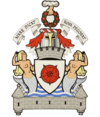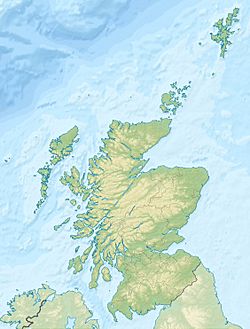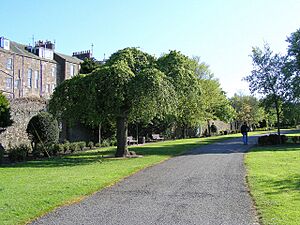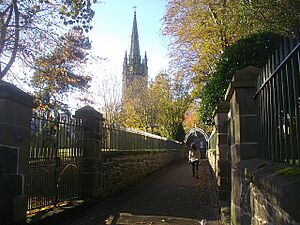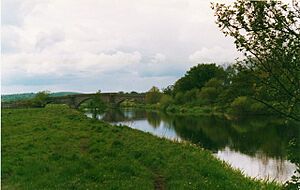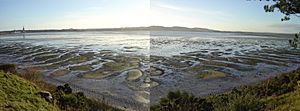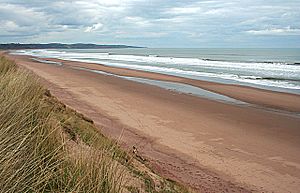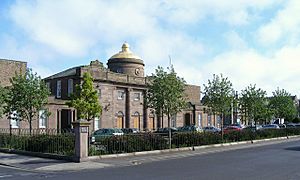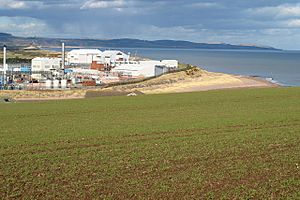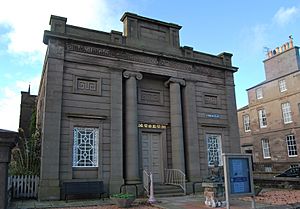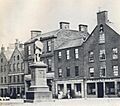Montrose, Angus facts for kids
Quick facts for kids
Montrose
|
|||
|---|---|---|---|
|
Town and former Royal burgh
|
|||
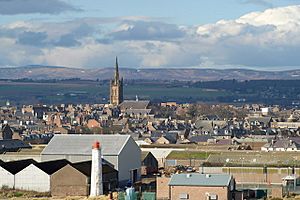
View of Montrose from Ferryden
|
|||
|
|||
| Etymology: The moor by the wood (from Scottish Gaelic) |
|||
| Motto(s):
Mare ditat, rosa decorat (Latin)
The sea enriches, the rose adorns |
|||
| Lua error in Module:Location_map at line 420: attempt to index field 'wikibase' (a nil value). | |||
| Sovereign State | |||
| Country | |||
| Local authority | |||
| Lieutenancy area | Angus | ||
| First settled | Neolithic period | ||
| Royal Charter | 1140 | ||
| Royal burgh abolished | 1975 | ||
| Population
(2020)
|
|||
| • Town | 11,730 | ||
| • Language(s) | English Scots |
||
| Demonym(s) | Montrosian Gable Ender |
||
| Postcode | |||
| Area code(s) | 01674 | ||
| OS Grid Reference | NO715575 | ||
Montrose is a town in Angus, Scotland. It's located about 28 miles (45 km) north of Dundee and 37 miles (60 km) south of Aberdeen. Montrose sits between the mouths of the North and South Esk rivers. It's the most northern coastal town in Angus. In the past, it grew as a natural harbour where people traded animal skins, hides, and cured salmon.
Today, Montrose has about 12,000 people. It's still an important port, but a big employer is GlaxoSmithKline, a pharmaceutical company. The town's skyline is famous for the 220-foot (67 m) steeple of Old and St Andrew's Church. This impressive building was designed by James Gillespie Graham and built between 1832 and 1834.
Montrose is known for its beautiful buildings and its role in international trade. It's a key commercial port for the oil and gas industry. The town has a wide main street with charming hidden gardens. You can also see the Montrose Basin, a large tidal lagoon that is a very important nature reserve. It's the biggest inland saltwater basin in the UK and a vital home for birds like the mute swan. Nearby, you can visit the 18th-century House of Dun, designed by the famous Scottish architect William Adam.
Contents
- History of Montrose
- How Montrose is Governed
- Geography and Nature in Montrose
- Population of Montrose
- Education in Montrose
- Economy and Tourism
- Culture and Entertainment
- Media in Montrose
- Places of Worship
- Transportation in Montrose
- Public Services
- Famous People from Montrose
- Twin Towns
- Montrose's Legacy
- Images for kids
- See also
History of Montrose
What's in a Name? Early History of Montrose
Long ago, there were signs of people living near Montrose, like the Stone of Morphie. One old name for Montrose was Celurca. The name Montrose comes from Scottish Gaelic words: Moine (meaning moor or peat moss) and Ros (meaning peninsula). It might even have come from the ancient Pictish language.
The first official record of Montrose is a royal document from David I around 1140. He called the town Sallorch or Sallork. By 1178, it was known as Munross, and later it became Montrose. Some people think the name means "Mount of Roses." This idea is shown in the town's motto: Mare ditat, rosa decorat, which means "The sea enriches, the rose adorns."
Montrose in Medieval Times
Montrose faced attacks many times from the Danes. In 980, the town was destroyed. For a long time, people thought there was a castle in Montrose in the 10th century that was ruined by Kenneth III, but this story might not be true.
In the 1140s, Montrose was an important trading town. The money from trade in Montrose, Forfar, and Dundee helped support Restenneth Priory. In 1178, William the Lion built a castle nearby, where he sometimes stayed. The ruins are now called Red Castle.
In 1296, during the Wars of Independence, Edward I visited Montrose with 30,000 soldiers. He stayed at Munros castle. Some stories say he took away the royal symbols from Scottish King John de Balliol here. The next year, William Wallace destroyed the castle, which was held by English soldiers. The place where the castle stood, called Castlestead, is at the south end of the High Street.
In the 15th century, the town's people had problems with the Lairds of Dun, who took their property and animals. James IV of Scotland eventually stepped in to help solve these issues.
Montrose in Modern Times
Montrose started as a port trading in skins and salmon. By the 17th century, it began exporting wheat and barley to the Hanseatic League. The town also imported flax and timber from the Baltic region, and salt, fruit, and wine from France and Portugal. This trade made the town wealthy. You can still see this wealth in the old houses built by rich families and in street names like "America Street" and "Baltic Street."
The famous James Graham, 1st Marquess of Montrose was born where the old castle stood. He first signed an agreement against King Charles I but later fought for the King. He was captured and executed in Edinburgh in 1650.
In the 18th century, Montrose was a big center for smuggling. The town also briefly profited from the slave trade. The wealth from trade was huge. Rich merchants built their houses very close together, which is why people from Montrose are sometimes called "gable-enders."
Samuel Johnson, a famous writer, visited Montrose in the 1770s. He said the town was "well-built, airy, and clean." He also noted the "handsome" town hall and a very clean English chapel with an organ.
In 1781, Scotland's first hospital for mental health, the Montrose Lunatic Asylum, was founded in Montrose. It later became Sunnyside Royal Hospital and helped people with mental illnesses until it closed in 2011.
Before World War I, the Royal Flying Corps built a base at Montrose, which became RAF Montrose. On February 26, 1913, it became the first military airfield in the United Kingdom.
Between the World Wars, Montrose was a hub for important Scottish writers and artists. Many famous figures like Hugh MacDiarmid and Violet Jacob lived or worked here. The sculptor William Lamb was born in Montrose and returned to the town in 1924.
During World War II, RAF Montrose was a training base for pilots from many countries. It also had fighter planes like the Hawker Hurricane and Supermarine Spitfire. This made the town a target for German planes, and it was bombed several times. Many children and mothers from Dundee were evacuated to Montrose for safety during the war.
Montrose was a royal burgh until 1975.
The Story of Bamse
Bamse was a brave St Bernard dog who is buried in Montrose. He was a Norwegian Sea Dog who arrived in Montrose during World War II with his owner, Captain Erling Hafto. Bamse was even registered as a crew member on the ship! He saved a sailor's life and protected his friends. Stories say he would stand on his hind legs, over 6 feet tall, and gently stop fights. When he died in July 1944, Montrose schools closed, and 800 children lined the streets for his funeral.
Later, people raised £50,000 to build a large bronze statue of Bamse at Montrose Harbour. Half of the money came from Norway. The statue was created by Alan Herriot and was unveiled in October 2007.
How Montrose is Governed
Montrose is part of the Montrose & District Ward within Angus Council. Four councillors are elected from this area to represent the town. As of 2022, these councillors are Bill Duff (Scottish National Party), Tommy Stewart (Independent), Kenny Braes (Scottish National Party), and Iain Gall (Conservative).
For the Parliament of the United Kingdom, Montrose is in the Angus and Perthshire Glens constituency. This area sends one Member of Parliament (MP) to the House of Commons in London. The current MP is Dave Doogan from the SNP.
Montrose is also part of the Angus North and Mearns constituency for the Scottish Parliament. This area elects one Member of the Scottish Parliament (MSP). The current MSP is Mairi Gougeon of the Scottish National Party.
Geography and Nature in Montrose
Montrose is located on the north bank of the Montrose Basin, where the River South Esk meets the North Sea. It's about 11 miles (18 km) northeast of Arbroath. The town is mostly flat, rising slightly to the north.
The town also includes the nearby villages of Hillside and Ferryden. The air quality here is good because it's a rural area.
Montrose Basin: A Wildlife Haven
The Montrose Basin is a shallow body of water, about three miles (5 km) wide. It's where the River South Esk flows into the North Sea.
In 1981, the Montrose Basin Nature Reserve was created. The Scottish Wildlife Trust has a modern wildlife center at Rossie Braes. From there, you can use telescopes to see the thousands of migratory birds that visit the area throughout the year.
In summer, you might spot an osprey hunting or a kingfisher flying by. A special bank for sand martins is very busy in spring and early summer. You can even watch blue tits and barn swallows inside their nests! The views of the rolling countryside are amazing.
In autumn, especially October and November, about 38,000 birds use the basin. In winter, 20,000 pink-footed geese live on the mudflats. They feed in nearby fields during the day and return to the safe basin in the evening. Their calls are a beloved sound for local people, marking the change of seasons.
Montrose Beach: A Sandy Stretch
Montrose has a 3-mile (5 km) long sandy beach that has won a Blue Flag award for its environmental quality. The nearby Traill Pavilion and Seafront Splash! area has an arcade, playground, café, and ice-cream stall, making it popular with both locals and visitors. North of the town, the River North Esk flows into the North Sea across the beach.
The beach has been eroding, meaning it's slowly shrinking, by about 2.8 to 7.0 meters (9 to 23 feet) each year. This is thought to be linked to climate change.
A group called the Save our Sands Campaign (SOS) was started in 2009 to raise awareness about this erosion. They are concerned that sand is being removed from the area. In 2006, 150,000 tonnes of sand were even sent to Aberdeen to help their beach. This upset the Montrose Golf Links, which has one of the oldest golf courses in the world built on the dunes. The dunes are becoming unstable, forcing the golf course to consider moving parts of it.
A film made by local filmmaker Anthony Baxter in 2009 helped bring attention to the issue. The film, called "SOS Montrose Dredging," can be found on YouTube. In November 2023, during Storm Babet, the beach eroded by another three meters, causing the promenade walkway to collapse.
Population of Montrose
In 2001, Montrose had 10,845 residents, making it the third-largest town in Angus.
Since World War II, the population of Montrose has grown. Many families from Dundee moved to Montrose during the war and decided to stay. This led to new housing being built in the 1960s. Some people from Poland who served with the British forces at RAF Montrose also settled here.
The town also has a growing number of older people, which has led to more nursing and residential homes. In 2008, the population of Montrose & District was about 15,013.
| Historic population of Montrose, Angus | |||||||||||
| Year | 1801 | 1811 | 1821 | 1831 | 1841 | 1851 | 1861 | 1871 | 1881 | 1891 | 1901 |
|---|---|---|---|---|---|---|---|---|---|---|---|
| Population | 7,975 | 8,955 | 10,338 | 12,055 | 13,402 | 14,328 | 14,563 | 14,548 | 14,973 | 12,883 | 12,427 |
| Year | 1911 | 1921 | 1931 | 1941 | 1951 | 1961 | 1971 | 1981 | 1991 | 2001 | 2011 |
| Population | 10,974 | 10,979 | 10,196 | 10,762 | - | 10,063 | 11,214 | 11,467 | 10,845 | 11,955 | |
|
Census: 1801–2001 |
|||||||||||
Education in Montrose
Montrose has six primary schools: Lochside, Ferryden, Southesk, Rosemount, Borrowfield, and St Margaret’s. The town also has one secondary school, Montrose Academy.
Economy and Tourism
Jobs and Businesses in Montrose
Montrose's economy has been growing since World War II. GlaxoSmithKline, a big pharmaceutical company, has provided many jobs since the 1950s. Other important employers include Tesco, Cooperative Group, Petrofac, National Oilwell Varco, Baker Hughes, and Argos.
In 2009, Sainsbury's planned to build a new supermarket, which would have created about 200 jobs. However, these plans were cancelled, and other shops were built there in 2018. Montrose was one of the first towns in Scotland to get super-fast fiber optic broadband internet.
Visiting Montrose: A Tourist Destination
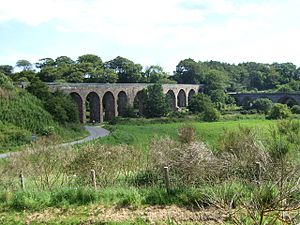
Since 2002, there has been a big effort to attract more visitors to Montrose. The Montrose Town Partnership was formed to help develop the town's economy for both locals and tourists. This group includes many local organizations like The Montrose Society and the Scottish Wildlife Trust.
They have created promotional leaflets and started a weekly Saturday market in the town center. In 2002, plans were made to improve the Mid Links area, which was completed in 2003. Plaques have been added to tell visitors about the history of the town's buildings.
Culture and Entertainment
Montrose's Artistic Heritage
Montrose is known as a center for culture and sculpture in Angus. There are over 20 statues around the town, many by the talented local sculptor, William Lamb. From the 1920s to 1940s, a local architect's studio was a place where artists and writers like Hugh MacDiarmid and Edwin Muir would meet and discuss ideas. The local newspaper, the Montrose Review, was even edited by MacDiarmid.
Music in Montrose
Since 2008, Montrose has hosted the Montrose Music Festival, also known as Mo Fest. It happens every year at the end of May. It has become Scotland's biggest free live music festival, with over 200 free concerts in more than 26 venues across the town. There's even an outdoor stage on Montrose's High Street, with the Montrose Steeple in the background.
In 2014, MoFest hosted a huge concert for 5,000 people with rock legends Status Quo. Other famous bands and artists who have played at MoFest include Average White Band, Deacon Blue, The Proclaimers, Bryan Adams, The Beach Boys, and Madness.
Film and Cinema
The Montrose Playhouse is a community cinema and arts venue that opened in 2021. It used to be a historic swimming pool. Now, it's a multi-purpose space that shows films, hosts live performances, and offers educational events. It's become an important cultural spot in the region, especially for independent films.
Sports in Montrose
Montrose is home to a golf course that is a qualifying course for The Open Championship. Many important golf events have been held here.
Links Park is where three football teams play:
- Montrose F.C., a professional team in League One.
- Montrose Roselea F.C., a junior team.
- Montrose W.F.C., a women's team that plays in the Scottish Women's Premier League.
Other sports clubs in Montrose include cricket, tennis, swimming, athletics, rugby union, sailing, and several bowls clubs.
Helen Matthews, a suffragette and women's footballer, was born in Montrose. She created the first-ever women's football team, which famously beat England 3–1 in 1881.
Media in Montrose
You can receive television signals in Montrose from the Durris or Angus TV transmitters.
Local radio stations include BBC Radio Scotland (92.7 FM) and Radio North Angus (87.7 FM).
The local newspapers are the Montrose Review and The Courier.
Places of Worship
Christian Churches
Montrose has many churches. Three belong to the Church of Scotland: Montrose Old and St Andrew's, Montrose: South, and Ferryden, Dun and Hillside Church. There is also Knox Church (United Free Church) and Grace Church Montrose (Free Church of Scotland).
Other churches include an Episcopal Church (St Mary's and St Peter's), the United Reformed Church, and the Methodist Church. A Quaker group also meets in town. The Roman Catholic community attends St Margaret's Roman Catholic Church. There is also a Baptist Church.
The most well-known church is the Old and St Andrew's Church, Montrose.
Other Faith Groups
In Borrowfield, there is a LDS Church (Church of Jesus Christ of Latter-day Saints) and a Kingdom Hall for Jehovah's Witnesses.
Transportation in Montrose
Montrose has a train station on the Dundee–Aberdeen line. You can catch trains to Aberdeen, Glasgow Queen Street, Edinburgh Waverley, Dundee, and Perth with ScotRail. Some London North Eastern Railway services also stop here, connecting to places like Leeds and London King's Cross.
Local bus services are mainly run by Stagecoach East Scotland. Buses connect Montrose to Arbroath, Brechin, and Dundee. The X7 Coastrider bus route, which runs between Aberdeen and Perth, also goes through the town.
Public Services
Scottish Water supplies water to Montrose from the Lintrathen and Backwater reservoirs. Electricity is provided by Scottish Hydro Electric plc.
Angus Council handles waste management. There's a kerbside recycling program that collects cans, glass, paper, and plastic bottles every week. Other materials are collected on alternate weeks. There's also a recycling center at Broomfield Road for many different items.
Healthcare in Montrose is provided by NHS Tayside. The closest hospital with an emergency room is Ninewells Hospital in Dundee. Local health care is available at the Links Health Centre. Montrose Royal Infirmary, a community hospital, closed in April 2018.
Police Scotland provides law enforcement, and Tayside Fire and Rescue Service handles fire emergencies.
Famous People from Montrose
- Anthony Baxter (born 1982), a documentary director.
- Robert Brown (1773–1858), a botanist who discovered Brownian motion.
- Alexander Allan (1809–1891), a locomotive engineer who invented important parts for trains.
- Edward Baird (1904–1949), an artist.
- Captain Sir Alexander Burnes (1805–1841), an explorer.
- David Carnegie (1772–1837), an entrepreneur and banker.
- Helen Cruickshank (1886–1975), a poet.
- Malcolm Duncan (1945–2019), a founding member of the band Average White Band.
- Michael Forsyth, Baron Forsyth of Drumlean (born 1954), a British politician.
- James Graham, 1st Marquis of Montrose (1612–1650), a poet and soldier.
- Joseph Hume (1777–1855), a doctor and politician.
- Allan Octavian Hume (1829–1912), a political reformer and expert on birds and plants in British India.
- William Lamb (1893–1951), a sculptor and artist.
- Violet Jacob (1863–1946), a writer and poet.
- David Erskine, Lord Dun (1670–1758), a judge who commissioned the House of Dun.
- John Erskine of Dun (1509–1591), a Scottish religious reformer.
- John Ewen (1741–1821), a songwriter.
- Sam Grove-White (born 1992), a professional rugby union referee.
- Fionn MacColla (1906–1975), a novelist connected to the Scottish Renaissance.
- Hugh MacDiarmid (1892–1978), a poet and important figure in the Scottish Renaissance.
- John McGovern (b. 1949), a football player and manager who captained Nottingham Forest to win the European Cup twice.
- Andrew Melville (1545–1622), a scholar and religious reformer.
- James Morrison (1932 – 2020), an artist.
- Willa Muir (1890–1970), a novelist and translator.
- William Barclay Peat (1852–1936), an accountant who helped found KPMG.
- Hercules Ross (1745–1816), a merchant and abolitionist.
- Horatio Ross (1801–1886), a sportsman, photographer, and politician.
- Gordon Smith (1924–2004), a footballer.
- George Wishart (1513–1546), a Protestant reformer.
- Helen Matthews (1857/8 – ?), a suffragette and women's footballer who created the first women's football team.
- Betsy Whyte (1919–1988), a Scottish traveler, singer, and storyteller.
Twin Towns
Montrose has been twinned with Luzarches, France, since 1994.
Montrose's Legacy
The town of Montrose in Houston, United States, is named after Montrose, Scotland.
Walter Scott's novel A Legend of Montrose is based on the military campaigns of the Earl of Montrose in the 1640s. The town of Montrose, Colorado, United States, takes its name from this book.
In J.K. Rowling's Harry Potter universe, there is a professional Quidditch team from Montrose called The Montrose Magpies.
Two Royal Navy ships have been named HMS Montrose after the Duke of Montrose.
Images for kids
See also
 In Spanish: Montrose (Angus) para niños
In Spanish: Montrose (Angus) para niños



